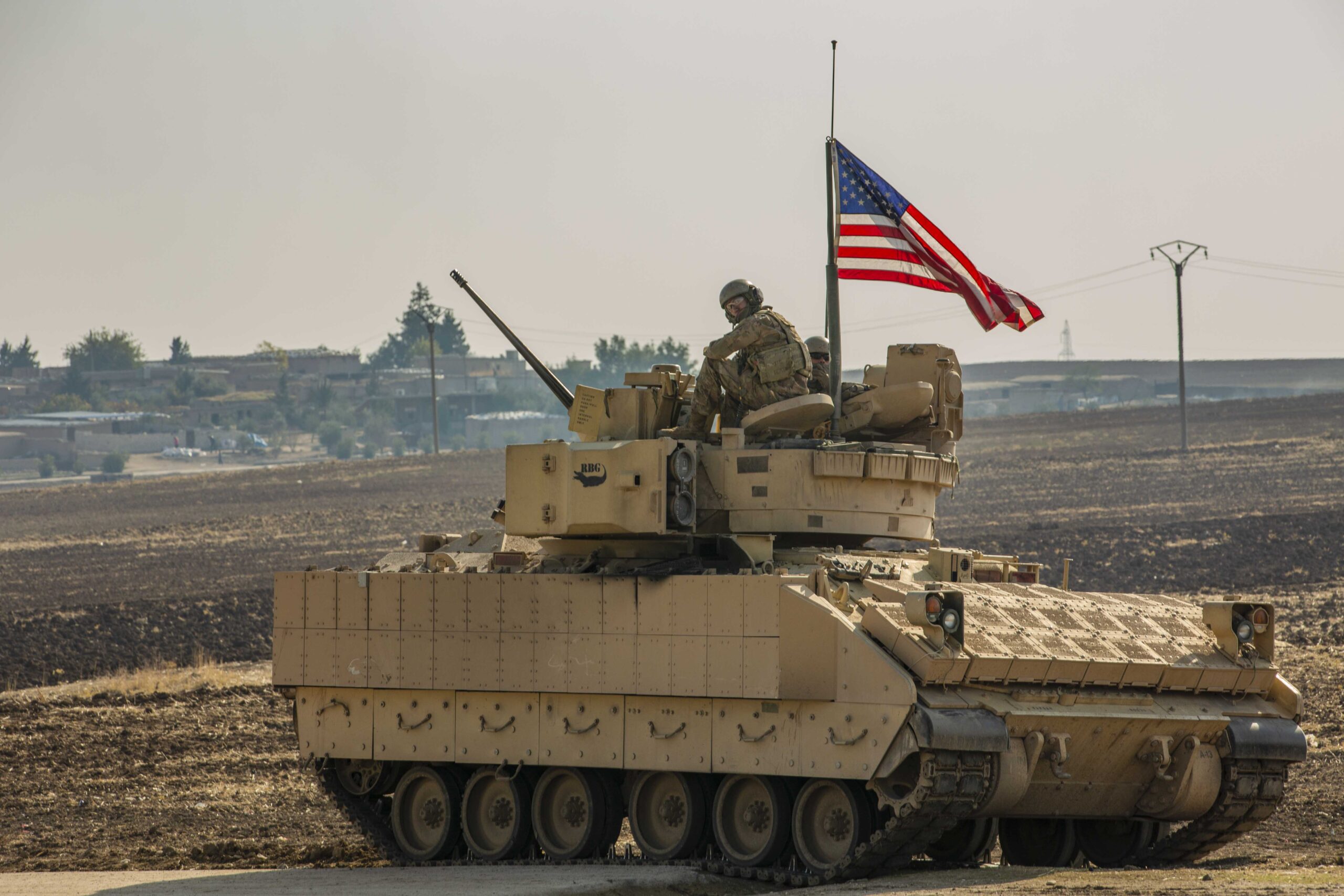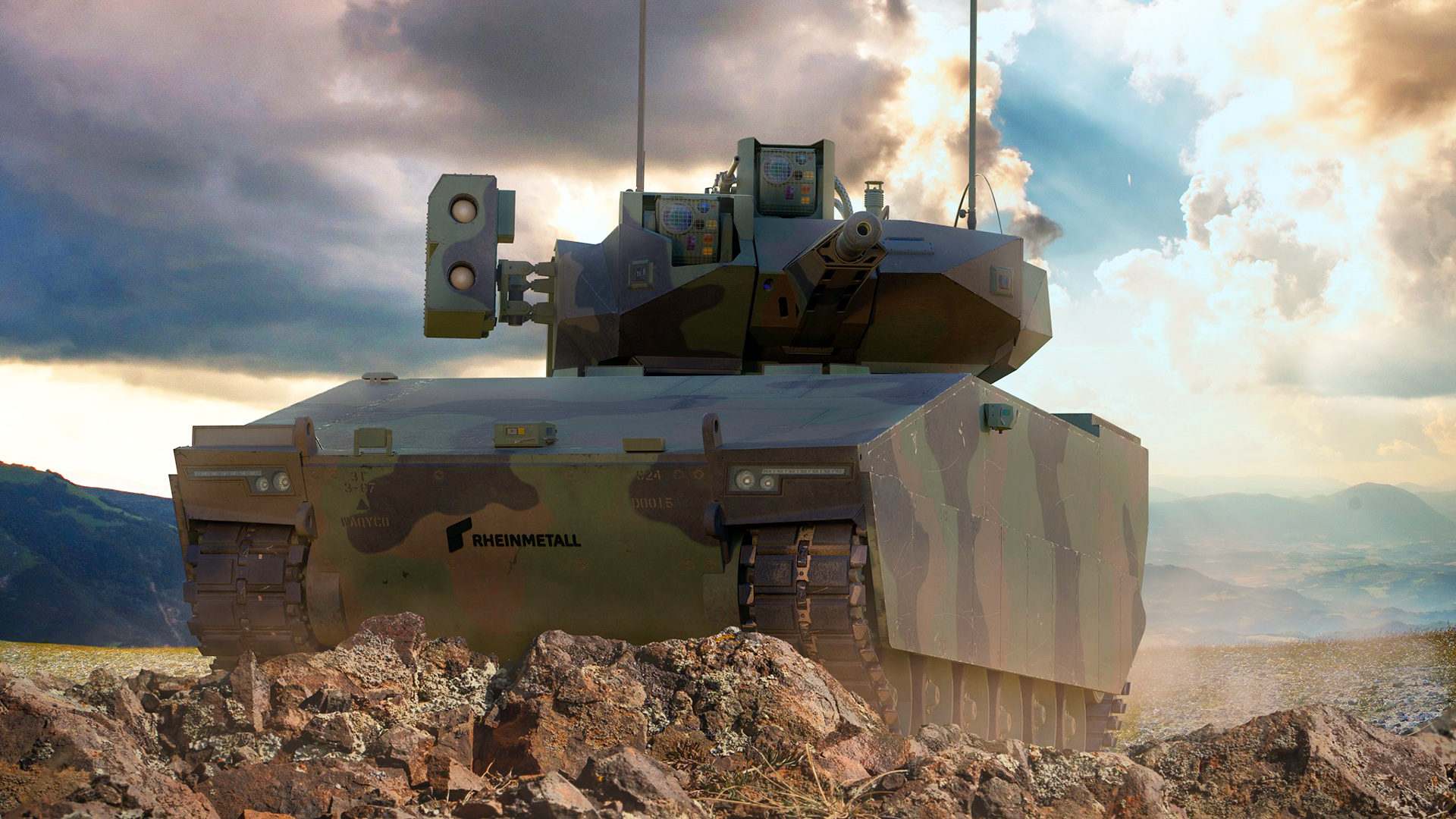American Rheinmetall, the U.S. subsidiary of the German weapons and automotive manufacturer, has unveiled a version of its Lynx infantry fighting vehicle that it is offering for the U.S. Army’s Optionally Manned Fighting Vehicle, or OMFV, program aimed at replacing the Bradley fighting vehicle. American Rheinmetall’s pitch will implement a variety of modifications to its existing Lynx vehicle, ranging from an unmanned turret to a small loitering drone launcher, in hopes of meeting the Army’s requirements for its next-generation armor fleet.
American Rheinmetall unveiled the Lynx OMFV during this year’s Association of the U.S. Army Annual Meeting and Exposition conference in Washington D.C., which is on its final day. The offering was developed under a multi-company consortium dubbed ‘Team Lynx’ led by American Rheinmetall, along with Raytheon Technologies, Textron Systems, L3Harris Technologies, Allison Transmission, and Anduril Industries.

Rheinmetall has been developing the Lynx series of tracked armored fighting vehicles since 2015. Originally designated as the KF31 infantry fighting vehicle (IFV), the inaugural variant in the family was first displayed at the Eurosatory defense exhibition in 2016 as a way to introduce a new generation of armor. Hungary is currently the only NATO and European Union member state to have purchased the Lynx, and deliveries are slated to arrive next year. Australia, Greece, Iraq, and the United States are all potential buyers, with offers in various stages having been made by the company. Lynx was also proposed to the Czech Republic and Slovakia, but was not selected.

The Army has selected four companies in addition to American Rheinmetall to participate in the early phases of the OMFV program, which includes BAE Systems, General Dynamics Land Systems, Oshkosh Defense, and Point Blank Enterprises. Each company is expected to have a bid ready to offer the Army by November 1, but American Rheinmetall has seemingly released their offering just under a month early. The OMFV contract could be worth up to $45 billion potentially for thousands of vehicles and is slated to be awarded to the winning company by 2027.

As it stands, the Army’s OMFV effort, which seeks to develop an optionally manned IFV with increased lethality and survivability to replace its aging fleet of M2 Bradleys, is still in the initial phases of the overall acquisition process. Essentially, American Rheinmetall has submitted its Lynx OMFV concept — capable of carrying two crewmen and six fully-equipped soldiers — not as a prototype but as a digital design for the Army to consider as it informs and matures its final OMFV requirements. With Rheinmetall being the first to reveal its digital OMFV design, its intriguing new high-tech additions could very well set the bar for how the remaining entrants will be considered.
Among these modernizations is Allison Transmission’s contribution to the design: the company’s eGen Force Transmission. eGen will allow the Lynx OMFV to enable electric hybrid propulsion as well as ‘electric only silent maneuverability’ as described by American Rheinmetall. This basically means that the way eGen distributes power throughout the vehicle will allow it to travel with little to no noise emittance under certain conditions. It is also important to note that this is the first time this propulsion technology has been used in a tracked Army vehicle.

Among Raytheon’s sensor and weapon contributions to the project is what the company has dubbed its ‘Multi-Mission Launcher.’ According to an American Rheinmetall, the Multi-Mission Launcher will be designed to fire anti-tank missiles like TOW and Javelin as well as launch Coyote Block 3 loitering munition drones all from the Lynx OMFV itself. The Army does, however, want to eventually replace TOW with a missile that will fit the existing TOW launch architecture, so the TOW replacement could be integrated into this launcher too, among other future weapons.

Another intriguing feature of the Lynx OFMV is the vehicle’s new American Rheinmetall-designed unmanned turret. In its current configuration, the turret will host a big, hard-hitting XM913 50mm cannon. The vehicle’s secondary remote weapon station is designed to accommodate a .50 caliber M2 machine gun along with other light and medium machine gun options, as well as grenade launchers.
The vehicle’s optimized two-crew approach, with a lot of automation built-in, also makes the leap to unmanned operations more seamless when the mission calls for it.
L3Harris will bring a modular open systems approach to the Lynx OMFV offering. In a press release, American Rheinmetall implied that L3Harris’ contributions will make up the vehicle’s overarching mission management system, as the company will be providing the electronics and cybersecurity that will ostensibly connect the vehicle’s sensor, communications, and targeting systems with the intent to ease crew workload and bolster situational awareness. This will comprise what American Rheinmetall has called the Lynx OMFV’s Ground Combat Systems Common Infrastructure (GCIA), which will host the modular electrical and software architecture.
“A 360-degree situational awareness system on the Lynx OMFV offers video for all crew members onboard and allows dismounts to prepare for their mission while moving to the objective,” read an American Rheinmetall press release. “The L3Harris WESCAM MX-GCS MK3 sight provides stabilized, digital thermal, TV, and IR capabilities with an integrated laser rangefinder and fire control unit. The flexible vehicle control architecture enables the operation of all vehicle systems from multiple locations.”

The software that will support Lynx OMFV’s GCIA will be developed by Anduril. The company will essentially provide the overall architecture’s digital backbone by fusing the vehicle’s onboard sensors to more accurately and efficiently represent targets of interest through what is being called the Common Tactical Picture (CTP). The CTP will act as a command and control center of sorts, which will be helpful in facilitating the transfer of target information up the chain of command to ensure that the right effects are being used to engage the right targets.
Beyond its advanced armor plating, to enhance survivability, American Rheinmetall added that the Lynx OMFV can be fitted with explosive reactor armor (ERA) as well as active protection systems. To enhance situational awareness, survivability, and the ability to return fire, the company says “with the integration of laser warning sensors, hostile fire detection, and an active protection system, the crew is able to identify threats and provide location information to the crew and higher commands.” They also claimed that their OMFV offering will support levels of speed and mobility that the company claims are on par with that of the M1 Abrams.
Textron Systems will be the U.S.-based manufacturing partner for Team Lynx. The company would build the Lynx OMFV’s chassis in collaboration with American Rheinmetall who will be manufacturing the turret structures at a co-located Textron System facility in Slidell, Louisiana. All in all, as Defense One noted in its own article on the unveiling, the Lynx OMFV production activities across all six Team Lynx companies will span 16 total states.

The Army’s OMFV program has for years been searching for a new and improved IFV to replace its existing fleet of M2 Bradleys a design that is well over 40 years old. While the vehicles have undoubtedly cemented themselves as a renowned means of infantry transport and fire support since their shaky development and entry into service in 1981, a Congressional Research Service (CRS) report explained that Bradleys have been updated so many times over the years to keep up with Army modernization efforts that the design has “reached the technological limits of its capacity to accommodate new electronics, armor, and defense systems.”
In October 2018, after three failed attempts to replace the Bradley, the Army officially announced the OMFV program as part of the Pentagon’s larger Next Generation Combat Vehicle (NGCV) effort. After a couple of years spent recalibrating the program’s requirements, the Army finally revealed a five-phase approach to OMFV acquisition in April 2020, and the effort is now in Phase II, or the Concept Design Phase.
Optionally manned capabilities are a predominant expectation of the OMFV program. In the same CRS report mentioned earlier, ‘optionally manned’ is listed first among the Army’s preliminary basic operational requirements for the OMFV, and it explains that the vehicle must have the ability to conduct remotely controlled operations while the crew is off-platform. The opportunity to keep soldiers off of the vehicle during certain operations would not only reduce the risk of losing human lives in combat, but it could improve the overall lethality of other manned platforms that would potentially work alongside and in conjunction with a future unmanned fighting vehicle. For instance, General Dynamics Land Systems sees its future Abrams tank as working alongside unmanned vehicles, of which the OMFV could be a candidate. The exact control and communications architecture, as well as the onboard autonomy systems, needed to make such a pairing a reality remains to be fully seen.

Regardless of its updated technology and capabilities, there is still debate over the relevance of heavy armor on the modern battlefield. While there has certainly been a rise in arguments insisting that such vehicles are no longer needed, especially if it were in something like a peer conflict in the Pacific, the central role of heavy armor throughout the war in Ukraine seems to be making a case otherwise.
As the November 1st digital design bid deadline approaches, it will certainly be interesting to see how other companies’ proposals stack up to American Rheinmetall’s. The stakes are certainly high, with decades of production and support and tens of billions of dollars potentially on the line for whoever ends up supplying the Army’s next top-end armored fighting vehicle.
Contact the author: Emma@thewarzone.com

